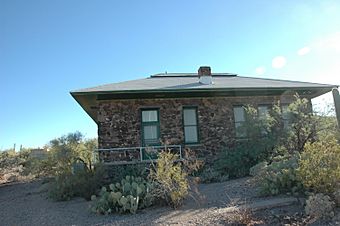Desert Laboratory facts for kids
|
Desert Laboratory — aka: Desert Botanical Laboratory; Tumamoc Hill; Tumamoc: People & Habitats
|
|
 |
|
| Location | 1675 West Anklam Road, Tucson, Arizona |
|---|---|
| Area | 860 acres (3.5 km2) |
| Built | 1903 |
| NRHP reference No. | 66000190 |
Quick facts for kids Significant dates |
|
| Added to NRHP | October 15, 1966 |
| Designated NHL | December 21, 1965 |
The Desert Laboratory is a special place in Tucson, Arizona, where scientists study how plants and animals live in the desert. It's located at 1675 West Anklam Road. This research center was started in 1903 by the Carnegie Institution for Science, a group that supports scientific research. Their main goal was to learn how plants survive and grow in hot, dry desert areas. It was the first time a private group funded such a big effort to study deserts in the United States!
Starting in 1906, scientists like Volney Morgan Spalding and Forrest Shreve set up many long-term study areas on Tumamoc Hill. This hill is a large scientific area, about 860 acres (3.5 km2) big. Nine of these study spots are the oldest permanent ecology study areas in the world! These scientists and the Desert Laboratory staff helped create the science of ecology, which is the study of how living things interact with each other and their environment. They even helped start the Ecological Society of America in 1915 and the Ecology journal. They also came up with new ideas for protecting nature.
Because of its important history, part of the Desert Laboratory was named a National Historic Landmark in 1965. The rest of the area was added to this special list in 1987.
Contents
History of the Desert Laboratory
The idea for the Desert Laboratory came from the Carnegie Institution of Washington. In February 1903, two important scientists, Frederick Vernon Coville from the United States Department of Agriculture and Daniel T. McDougal from the New York Botanical Garden, chose Tumamoc Hill as the perfect spot. The laboratory officially opened its doors in October of that same year.
Today, the Desert Laboratory is run by a group called Tumamoc: People & Habitats. This group is part of The University of Arizona's College of Science, continuing the important research and education about desert life.
Who Leads the Desert Laboratory?
The current director, or leader, of the Desert Laboratory is Benjamin Wilder.
Visiting Tumamoc Hill Road
You can walk up the road on Tumamoc Hill and enjoy the views! However, there are some rules to follow to protect the area:
- You can walk almost to the very top.
- The road is closed to walkers from 7:30 AM to 5:30 PM, Monday through Friday.
- You must stay on the road at all times.
- Bicycles and pets are not allowed on the hill.
- The very top of the hill is an important historical site, so you cannot go there without supervision.
- Only authorized people can drive vehicles on the road.
More to Explore
If you want to learn even more about the Desert Laboratory, you can check out this book:
- "Discovering the Desert: The Legacy of the Carnegie Desert Botanical Laboratory" by William G. McGinnies, published in 1981.
Images for kids





